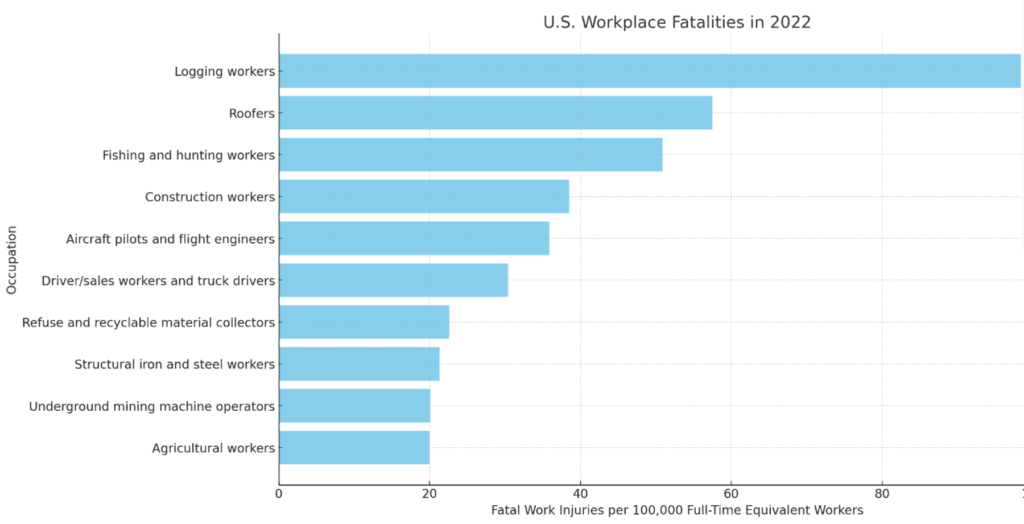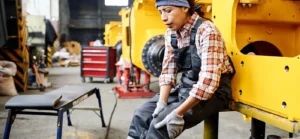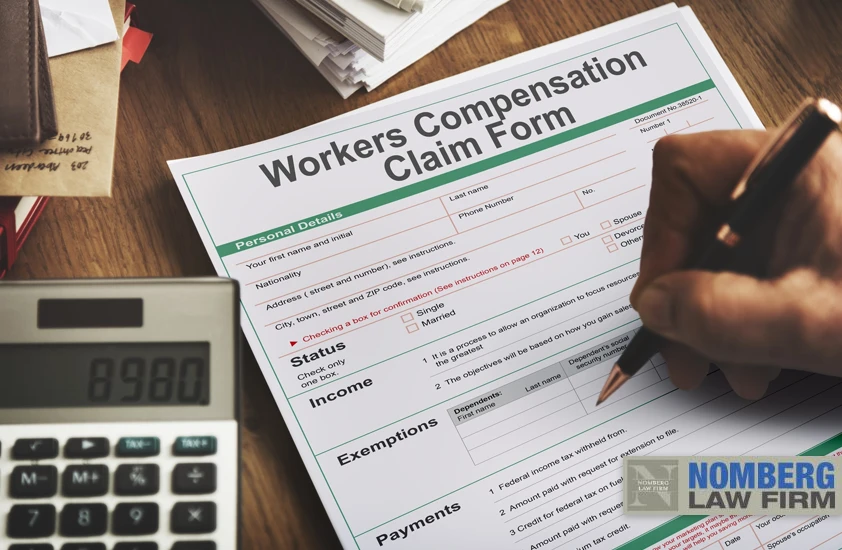When an employee enters a profession, they likely understand the risks of their job. While an injury is possible in any line of work, there’s no denying that some jobs have higher risks of injury than others.
For those working in a high-risk job, it’s important to know your workers’ compensation rights and understand that every employee is entitled to workers’ compensation benefits if injured on the job, no matter the risk.
Most dangerous jobs for workers in Alabama and across the U.S.
While the reality is that workers can get injured at any job, some professions simply carry more risks.
Here’s a look at some of the most dangerous jobs across the U.S. based on fatal injury rates in 2022 from the Bureau of Labor Statistics (BLS). For comparison, the average fatality rate for all workers that year was 3.7 per 100,000 full-time workers.

Some especially high-risk jobs in Alabama include:
- Roofers
- Factory workers
- Construction workers
- Police officers and first responders
- Delivery workers and UPS drivers
- Loggers and landscapers
- Utility workers
- Airplane pilots
- Farmers
- Mining machine operators
- Sanitation workers
- Truck drivers
- Commercial fisherman
These jobs carry a higher risk due to the devastating impact of the injuries associated with them. Machine malfunctioning is more likely to end a career than many other types of injuries that may only cause temporary disability.
Despite rigorous safety protocols in professions like construction, carelessness, even a small amount, can lead to permanent disabilities and fatal work injuries, making workers’ compensation benefits extremely important for injured employees and their families.
Why do workers’ comp cases move so slowly?
Discover the top reasons for delays in workers’ compensation cases and what you can do about it.
What are the most common workplace injuries in Alabama?
The nonfatal work injury rate in Alabama in 2022 was 2.3 per 100 full-time equivalent workers, slightly lower than the nonfatal injury rate for all U.S. workers, which was 2.7, according to the BLS.
Common injuries include:
Transportation injuries
These include accidents involving vehicles, whether within the workplace or in a work-related travel context. Common instances include collisions in work vehicles, being struck by moving vehicles, or accidents while operating heavy machinery like forklifts. Resulting injuries often include whiplash, internal bleeding, traumatic brain injuries, and spinal cord injuries.
Commonly resulting from activities such as lifting, pushing, pulling, or carrying heavy objects, overexertion can lead to strains, sprains, and muscle tears. These injuries frequently occur in industries that require manual labor.
These accidents occur on same-level surfaces and at heights (e.g., falling from ladders or scaffolding). Causes often include wet floors, uneven surfaces, cluttered walkways, and inadequate fall protection. Common injuries from these accidents include head injuries, back injuries, and broken bones.
Injuries from contact with equipment
Workers frequently suffer severe cuts, burns, amputations, and crush injuries when interacting with machinery, tools, and other equipment. Such incidents often result from improper use, a lack of safety guards, or equipment malfunctions.
Injuries from exposure to toxic substances or environments
These include health issues arising from contact with hazardous chemicals, biological agents, or extreme conditions. Workers might experience respiratory problems, skin conditions, poisoning, burns, and even hearing loss, depending on the type of exposure.
Other common work injuries we handle
At Nomberg Law Firm, we have experience with all types of occupational diseases, illnesses, and injuries. Below are some of the most common:
- Hurt at work? Get help for whiplash injuries in Alabama
- Electrical injuries on the job? Workers’ comp benefits in Alabama
- Workers’ comp for an occupational illness
- Workers’ comp for post-traumatic stress disorder
- Repetitive strain injuries (RSI) at work
- Workplace slips, trips & falls and workers’ comp
- Head and brain injury
- Back injury on the job
- Alabama workers’ compensation for brain bleed injuries
- How to get Alabama workers’ comp after a brake-check accident
- Muscle strains & sprains at work? Know your workers’ comp rights
- Work-related eye injury
- Alabama forklift accident injuries
- Carbon monoxide poisoning on the job
- Injured by heavy equipment at work
- Amputation injuries or loss of limbs
- Knee injury on the job
- Alabama workers’ compensation for hearing loss
- Alabama workers’ compensation for ladder & scaffolding injuries
Am I eligible for Alabama workers’ comp benefits after an injury?
In Alabama, workers’ compensation benefits are available to most employees who suffer a work-related injury, illness, or disease. This includes full-time, part-time, seasonal, and temporary workers.
Eligibility typically extends to those working for employers with 5 or more employees, with some notable exceptions, including independent contractors, domestic employees, agricultural employees, and workers who construct single-family, detached residential dwellings.
Workers only need to be able to prove that their injury, illness, or disease is a direct result of their work to receive benefits, which can include medical treatment, wage replacement, vocational rehabilitation services, and death benefits, depending on the severity and nature of their condition.
How can we reduce workplace injuries in Alabama?
An employer should educate and train their employees on proper safety procedures to reduce the risks in high-risk jobs. It’s important, not only to employees but to an employer as well, to ensure there are as few accidents as possible.
An employer with a high rate of accidents generally must pay a higher workers’ compensation premium. By ensuring that employees are as safe as possible, workplace accidents can be greatly diminished, to the benefit of both the employer and the employees.
Future of workplace safety: Wearable technology for a safer Alabama
Prevent unsafe working conditions by exploring wearable technology in the workplace.
Injured at work in Alabama? Get help from an experienced Birmingham workers’ compensation attorney.
If you are employed in a high-risk job, be careful. Work smart. If you become injured at work, report the accident to your supervisor and seek medical treatment. If you have questions about workers’ compensation benefits, please contact Nomberg Law Firm.
At Nomberg Law Firm, our knowledgeable Birmingham work injury attorneys have been helping injured Alabama workers get maximum compensation for their claims since 1967. We can walk you through the process, help you gather evidence to support your claim, and handle all negotiations with the insurer so you can focus on recovering from your injuries.
Interested in learning more?
Contact Nomberg Law Firm today to schedule a free consultation.
References
Civilian occupations with high fatal work injury rates. (n.d.). Www.bls.gov. https://www.bls.gov/charts/census-of-fatal-occupational-injuries/civilian-occupations-with-high-fatal-work-injury-rates.htm
Employer-Reported Workplace Injuries and Illnesses in Alabama — 2022 : Southeast Information Office : U.S. Bureau of Labor Statistics. (n.d.). Www.bls.gov. Retrieved March 8, 2024, from https://www.bls.gov/regions/southeast/news-release/workplaceinjuriesandillnesses_alabama.htm#SOII_Table1Alabama.xlsx.f.1


